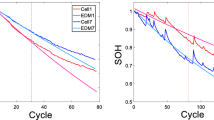Abstract
Reproducible machine learning models with less number of parameters and fast optimization are preferred in embedded system design for the applications of artificial intelligence. Due to implementation advantages, symbolic regression with genetic programming has been used for modeling data. In addition, extreme learning machines have been designed with acceptable performances in virtue of random learning strategy. In this paper, symbolic regression featured extreme learning machine models are proposed for the system identification. The symbolic regression layer with mathematical operators and basis functions has been randomly constructed instead of genetic programming whereas the output weighting parameters are optimized via least-squares optimization as in extreme learning machines. Consequently; implementable, efficient and easy designed models are constructed for future applications. Comparative results of the proposed and literature models present that proposed models provided smaller mean-squared errors and minimum-descriptive length performances.







Similar content being viewed by others
References
Ljung L (1999) System identification. Wiley encyclopedia of electrical and electronics engineering. Wiley, Hoboken, pp 1–19
Kumpati SN, Kannan P et al (1990) Identification and control of dynamical systems using neural networks. IEEE Trans Neural Netw 1(1):4–27
Huang G-B, Chen L, Siew CK et al (2006) Universal approximation using incremental constructive feedforward networks with random hidden nodes. IEEE Trans Neural Netw 17(4):879–892
Li L, Zhao K, Li S, Sun R, Cai S (2020) Extreme learning machine for supervised classification with self-paced learning. Neural Process Lett 58:1–22
Ragusa E, Gianoglio C, Gastaldo P, Zunino R (2018) A digital implementation of extreme learning machines for resource-constrained devices. IEEE Trans Circuits Syst II Express Briefs 65(8):1104–1108
Lv W, Kang Y, Zheng WX, Wu Y, Li Z (2020) Feature-temporal semi-supervised extreme learning machine for robotic terrain classification. Express briefs. IEEE Trans Circuits Syst II 67:3567–3571
Koza JR, Koza JR (1992) Genetic programming: on the programming of computers by means of natural selection, vol 1. MIT Press, Cambridge
Meredig B, Wolverton C (2013) A hybrid computational-experimental approach for automated crystal structure solution. Nat Mater 12(2):123–127
Schmidt M, Lipson H (2009) Distilling free-form natural laws from experimental data. Science 324(5923):81–85
La Cava W, Danai K, Spector L (2016) Inference of compact nonlinear dynamic models by epigenetic local search. Eng Appl Artif Intell 55:292–306
Derner E, Kubalík J, Ancona N, Babuška R (2020) Constructing parsimonious analytic models for dynamic systems via symbolic regression. Appl Soft Comput 94:106432
Chen Q, Zhang M, Xue B (2017) Feature selection to improve generalization of genetic programming for high-dimensional symbolic regression. IEEE Trans Evol Comput 21(5):792–806
Wang Y, Wagner N, Rondinelli JM (2019) Symbolic regression in materials science. MRS Commun 9(3):793–805
Niu P, Ma Y, Li M, Yan S, Li G (2016) A kind of parameters self-adjusting extreme learning machine. Neural Proces Lett 44(3):813–830
Schmidt MD, Lipson H (2008) Co-evolving fitness predictors for accelerating evaluations and reducing sampling
Sierra A, Macias JA, Corbacho F (2001) Evolution of functional link networks. IEEE Trans Evol Comput 5(1):54–65
Beyhan S, Kavaklioglu K (2015) Comprehensive modeling of u-tube steam generators using extreme learning machines. IEEE Trans Nuclear Sci 62(5):2245–2254
Söderström T, Stoica P (1989) System identification. Prentice-Hall International, Upper Saddle River
Tang Y, Han Z, Liu F, Guan X (2016) Identification and control of nonlinear system based on Laguerre-ELM wiener model. Commun Nonlinear Sci Numer Simul 38:192–205
Mastorocostas PA, Theocharis JB (2002) A recurrent fuzzy-neural model for dynamic system identification. IEEE Trans Syst Man Cybern Part B Cybern 32(2):176–190
Beyhan S, Alci M (2010) Fuzzy functions based ARX model and new fuzzy basis function models for nonlinear system identification. Appl Soft Comput 10(2):439–444
Reddy R, Saha P (2017) Modelling and control of nonlinear resonating processes: part I–system identification using orthogonal basis function. Int J Dyn Control 5(4):1222–1236
Hernandez E, Arkun Y (1996) Stability of nonlinear polynomial ARMA models and their inverse. Int J Control 63(5):885–906
Al-Ajlouni AF, Schilling RJ, Harris S (2004) Identification of nonlinear discrete-time systems using raised-cosine radial basis function networks. Int J Syst Sci 35(4):211–221
Author information
Authors and Affiliations
Corresponding author
Additional information
Publisher's Note
Springer Nature remains neutral with regard to jurisdictional claims in published maps and institutional affiliations.
Rights and permissions
About this article
Cite this article
Köktürk-Güzel, B.E., Beyhan, S. Symbolic Regression Based Extreme Learning Machine Models for System Identification. Neural Process Lett 53, 1565–1578 (2021). https://doi.org/10.1007/s11063-021-10465-2
Accepted:
Published:
Issue Date:
DOI: https://doi.org/10.1007/s11063-021-10465-2




